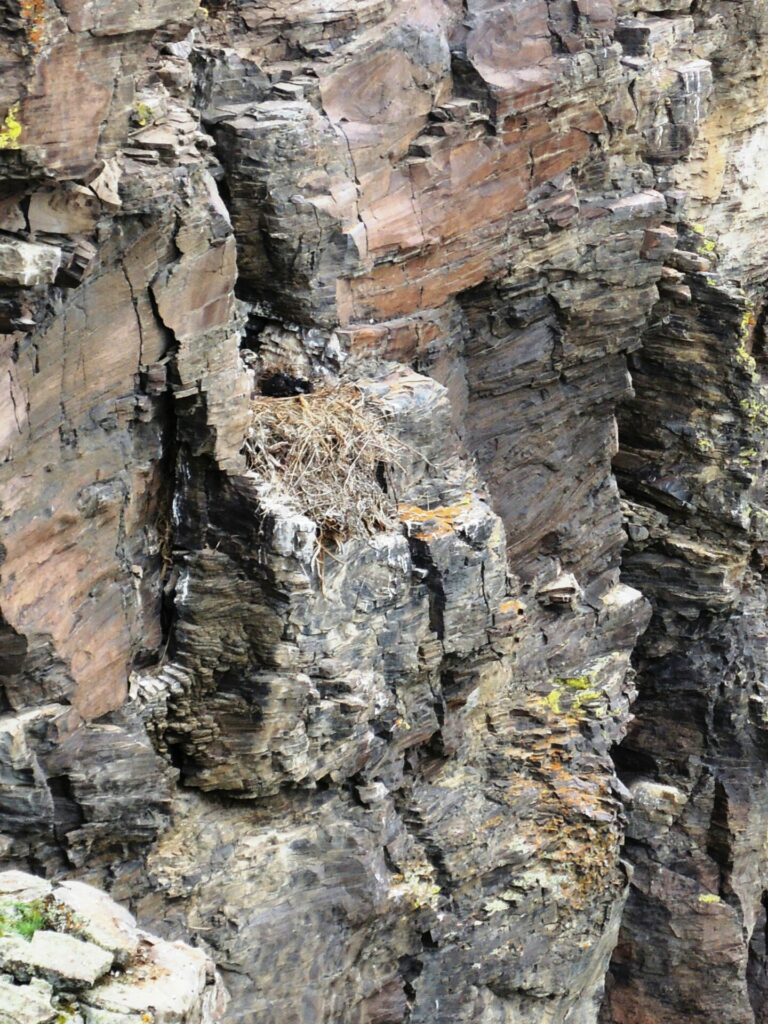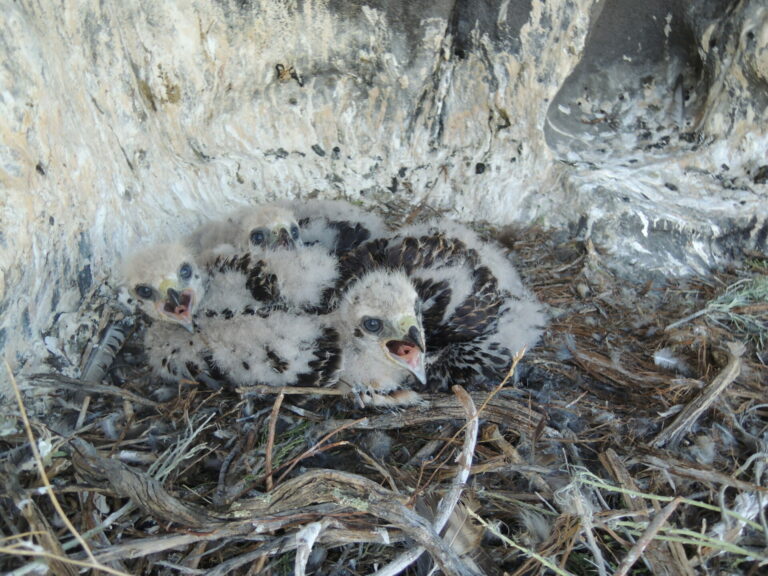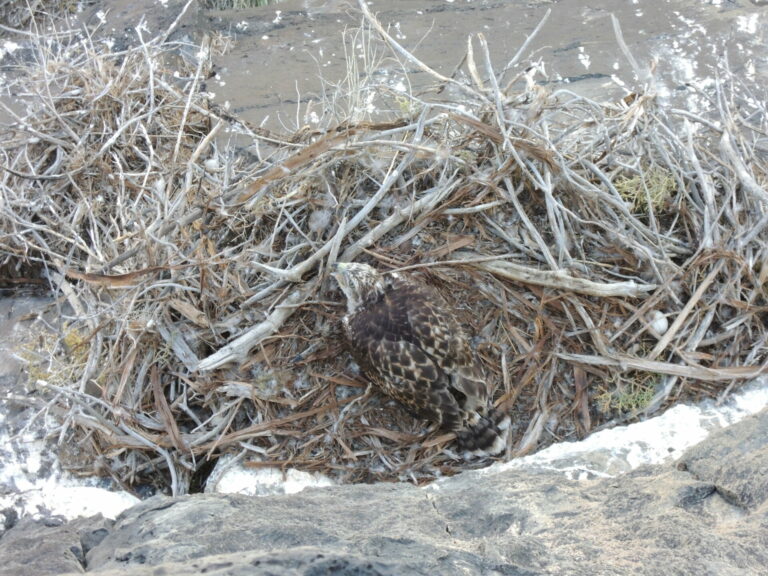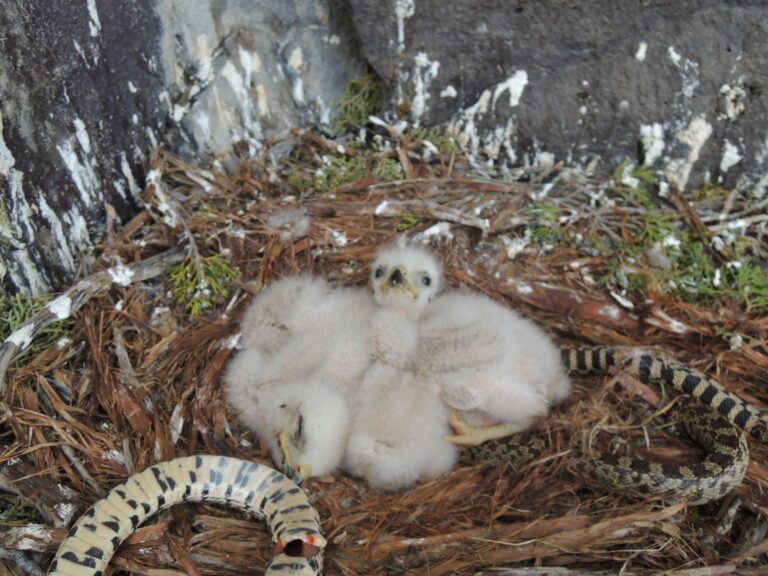On the Road is a weekday feature spotlighting reader photo submissions.
From the exotic to the familiar, whether you’re traveling or in your own backyard, we would love to see the world through your eyes.
Ex-lurker
Finishing up with my posts on raptors, here are some nests I’ve found in the last few years–mostly red tails. I time my visits for when the eyasses are old enough to thermoregulate, and I am in and out in a few minutes. These nests are all found way out in the backcountry, where they are unlikely to get other visitors.

This is a Golden Eagle eyrie. I couldn’t get any closer without a rope, but if you zoom in you can just make out the two young. I was looking on this cliff for prairie falcon eyries, because I took a couple of tiercels out of an eyrie here many years ago. When I came up to the edge of the cliff, the male flew off the nest. You don’t usually find golden eyries by hanging out on the top of the cliff because, unlike many raptors, they just slip quietly off the nest and disappear when someone appears, rather than raising a fuss and alerting you to the presence of the nest. I usually find them by walking along the bottom of the cliff, looking for the nest and the wash of feces below it. It’s interesting that eagles are not aggressive around their nests, since they would obviously be pretty damn intimidating if they decided to guard them. I went back with a rope a couple of years later, and there was a peregrine eyrie near where this eagle eyrie had been. I don’t have photos because I didn’t want to drop into an eyrie in the backcountry without someone else near. Peregrines are aggressive around their eyries, although they (usually) won’t hit you, particularly if you keep your eye on them. Turn your head away, however, and sometimes one of the parents will bang your head. (Keep looking at a goshawk or ferruginous hawk when it’s diving at you around the nest and you’re liable to lose an eye.)

These redtail eyasses are about 3 weeks old.

I found this redtail eyrie on a bluff overlooking the Snake River west of American Falls, Idaho more than 40 years ago. Every time I’ve returned since, there’s been young in the nest. This little male is probably the great, great (keeping adding many greats) grandson of the original pair.

These redtail eyasses are about 2 weeks old (they’re fine, notwithstanding that one of them has his head drooping down–they just look like that when they’re young, especially after they’ve eaten). This pair seems to specialize in snakes. I originally found this nest when I saw a male flying by with a snake hanging below him, and every time I’ve gone into this eyrie there are remains of snakes. I think these remains are gopher snake, although I’ve found rattlesnake remains in the nest. T

This redtail nest is in the Curlew National Grassland in southern Idaho. It’s interesting to me, because it’s in an old squashed-down magpie nest not even 15 feet up in a Russian olive. The Curlew grassland, unlike a lot of southern Idaho, doesn’t have a lot of suitable cliffs for nests, nor large trees, so this pair took what was available. I keep returning to the Curlew grassland looking for ferruginous hawk nests (I’ve seen adults there during breeding season often), but I’ve never been able to find one.

eversor
Raptors are some of the most beautitful creatures out there. We have a couple types around here and a neighbor learned the hard way that if you leave out a bird feeder in winter you have just created a buffet for (I think) sharp shinned hawks.
OzarkHillbilly
Good stuff, Ex-lurker. Love the snakey nest.
@eversor: And Cooper Hawks.
Anyway
Fascinating pictures. Chicks are totes adorable.
Kristine
Love this raptor series.
I have a Cooper’s hawk visit my backyard on occasion. A few years ago I watched it glide from the dwarf crabapples–where the feeder was–to my back gate and just sit there. All the birds had gone quiet, even the sparrows that used one of the holly bushes along the back wall of the house as a conference center. I saw a couple of sparrows peek out from between the leaves; one finally made a break for it and the hawk took off, banked like whoa around the back of the bush, and snatched it.
I still marvel at how the hawk avoided hitting the house.
MelissaM
The babes with the snakes around them – creepy! (Why’d it have to be snakes?)
This was an interesting series! Thanks for sharing.
Betty
Fascinating posts.
WaterGirl
Ex-lurker: Thanks so much for the interesting series!
I added “Raptors” as a category under OTR, so that should make it easier if anyone wants to find them. There was also a raptor post from The Other Hank, so I tagged that one, too.
AM in NC
This was a great series of posts – I learned a lot and the pictures were very cool. Thank you!
Antid Oto
I am also mostly a lurker, and emerging merely to say that I find this post disturbing. This behavior of dropping into active nests to disturb breeding progress and even stealing chicks strikes me as highly unethical.
Jharp
“Peregrines are aggressive around their eyries”
I remember this from reading My Side of the Mountain circa 1970.
I really loved that book as a kid.
J R in WV
@Antid Oto:
Great photos, but I also am stricken by the lack of ethics regarding these endangered species. Should be left alone… “falconry” isn’t a sport, it’s enslavement of wild things.
jackson
@Antid Oto: I did not see anywhere that chicks were disturbed or taken. Did I miss something?
StringOnAStick
@Antid Oto: In the first post in this series he said that now he only does this to band the birds; he’s no longer collecting and most birds used in falconry here are captive bred. Banding birds is useful for wildlife research.
dp
Great, fascinating series. After I read H is for Hawk, I briefly considered taking up falconry, but once the wondrous imaginings working with these spectacular birds wore off, I realized that I had no interest in captivating a wild bird, nor in killing squirrels and rabbits since I’m the only one in my family who would eat them.
A woman from anywhere (formerly Mohagan)
Properly done, falconry seems to be an all-encompassing life style. I went to an Audubon meeting once with a falconer presenter, and he said a common saying was “one hawk, a life, 2 hawks, no wife, 3 hawks, no life” (I am paraphrasing). The gist being, the hawks take over your life.
Antid Oto
@StringOnAStick: In that case I withdraw the comment.